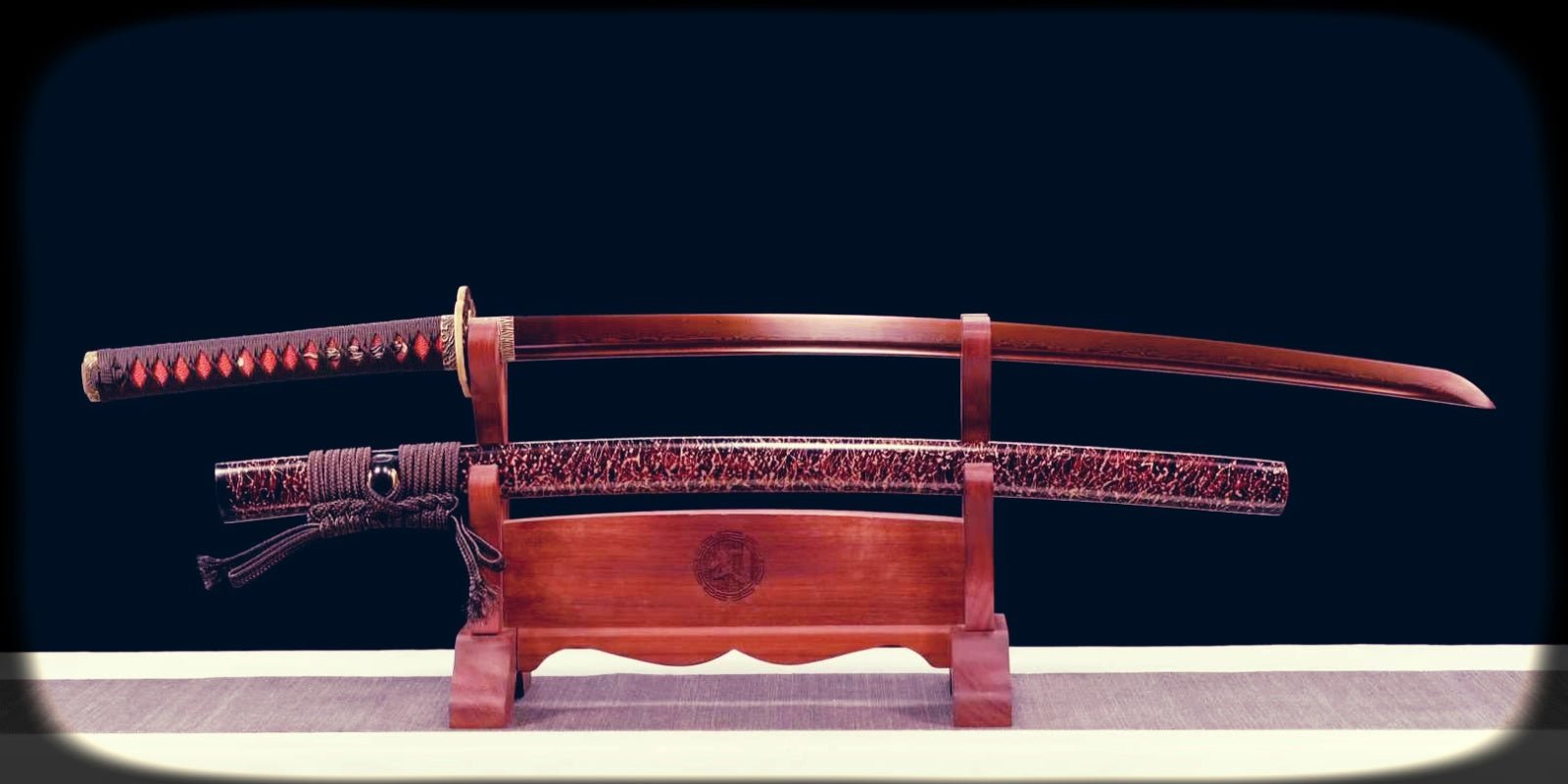Introduction: The Artistry and Legacy of Japanese Swordsmiths
The artistry of Japanese swordsmiths stands as an enduring testament to precision, innovation, and cultural heritage. At the pinnacle of craftsmanship, the ten legendary katana swords of Japan exemplify unparalleled mastery, reflecting centuries of tradition. Renowned figures like Bizen Nagamitsu carved a legacy forged in steel, while Kanemitsu became revered as a swordsmith of divine precision. Iconic blades such as the Honjo Masamune, hailed as a symbol of unity, and the double-edged Kogarasu Maru define artistry and historical significance. The enigmatic Muramasa blades, known for their controversial legend, add layers of mystery.
Authenticity is paramount in appreciating these weapons of history. Antique Nihonto katana signed by Naokuni, alongside exquisite blades attributed to Tegai—accompanied by NBTHK Tokubetsu Hozon and Tokubetsu Kicho Token certificates—preserve their authenticity and value. Collectors of authentic Nihonto seek these certificates, ensuring genuine lineage. Through intricate forging techniques and a relentless pursuit of perfection, Japanese swords transcend mere weaponry, becoming symbols of artistry and cultural identity that resonate through history.
The Origins of Japanese Swordsmithing: A Brief History
Japanese swordsmithing traces its genesis to ancient times, emerging as an art form deeply rooted in practicality, spirituality, and regional necessity. The crafting of early swords, such as the Chokutō—a straight, single-edged blade—marked the foundation for Japan's distinctive blades. By the Heian period (794–1185), sword-making evolved, leading to groundbreaking techniques that informed later masterpieces like the Honjo Masamune and the legendary Kanemitsu. The Kamakura period saw the development of the curved katana, with regions like Bizen producing iconic swords through masters like Bizen Nagamitsu. This era solidified the legacy of authentic Nihonto, revered for exquisite craftsmanship.
Amakuni: The Legendary Creator of the Katana
Amakuni is often credited as the progenitor of the katana, a weapon that has become synonymous with samurai culture and ancient Japan. His contributions are linked to the genesis of the uniquely curved blade—a design that significantly enhances its strength and slicing capability. Historical accounts reveal Amakuni's craftsmanship led to innovations that defined authentic Nihonto, including forging techniques admired across generations.
It was Amakuni’s dedication that elevated the swordsmith's craft, paving the way for icons like the legendary Kanemitsu, the Honjo Masamune, and the enigmatic Muramasa blades. His mastery shaped the foundation on which later katana masters built their legacies.
Masamune: The Master of Elegance and Harmony in Swordsmithing
Masamune, the legendary katana craftsman of Japan, remains one of the most celebrated swordsmiths in history. Renowned for creating masterpieces like the Honjo Masamune, his work symbolizes perfection in both artistic elegance and functional precision. The swords crafted by Masamune embody exceptional harmony, resisting corrosion and maintaining unparalleled sharpness. Unlike the enigma of Muramasa blades, Masamune’s creations reflect balance rather than chaos, making them prized by military leaders and collectors alike. Techniques such as hada folding and meticulous heat treatment highlight his mastery of steel, leaving an enduring legacy. Authentic Nihonto signed by Masamune hold immense historical and monetary value.
Muramasa: The Infamous Swordsmith Known for Cursed Blades
Muramasa Sengo, a prolific 16th-century swordsmith, remains one of the most enigmatic figures in Japanese history. Renowned for crafting blades of extraordinary sharpness and strength, his swords earned infamy due to their rumored "cursed" nature. Unlike the divine precision of The Honjo Masamune, regarded as the pinnacle of katana craftsmanship, Muramasa’s works allegedly drove their wielders to acts of uncontrollable violence. Legends describe his blades as thirsting for blood, enhancing their mystique.
While swords like The Enigma of Muramasa Blades: Unsheathing the Legend fascinate collectors, they also raise authenticity concerns. Ensuring value requires certificates like the NBTHK Tokubetsu Hozon Token Certificate for antique Nihonto. Tales persist of supernatural consequences tied to owning blades attributed to Muramasa, making their intrigue timeless.
Yoshimitsu: The Founder of Gokaden and His Influence on Sword-making Schools
Yoshimitsu, renowned as the founder of one of Japan's Five Gokaden or Five Great Sword-making Schools, profoundly shaped the art of nihonto. His crafts symbolize the refined craftsmanship found in authentic nihonto and highlight the importance of precision in forging. The antique nihonto katana signed by Naokuni and attributed to Tegai attest to his influence. Yoshimitsu’s intricate design approach inspired swordsmiths like Bizen Nagamitsu and Kanemitsu. Legendary swords such as the Honjo Masamune and Kogarasu Maru reflect his era's innovation. Collectors now seek work preserved with NBTHK certificates, emphasizing authenticity and value.
Kanesada: The Innovation and Craftsmanship of the Seki Tradition
Kanesada's artistry embodies the Seki tradition, a cornerstone of Japanese sword-making history. Known for creating some of the finest swords among the ten legendary katana swords of Japan, Kanesada combined technical brilliance with aesthetic mastery. His blades often showcased the mastery of Bizen Nagamitsu's techniques, blending robust steel forging with intricate patterns.
Recognized alongside celebrated figures like Kanemitsu, whose swords reflect divine precision, Kanesada innovated designs that elevated functionality and aesthetic appeal. The Seki region, famed for producing authentic Nihonto and antique Nihonto katana, benefitted greatly from his contributions. Collectors cherish Kanesada’s work for its rarity and historical significance, often accompanied by NBTHK certificates ensuring authenticity and value.
The Role of Swordsmithing in Japanese Samurai Culture
Swordsmithing held an esteemed position in Japanese samurai culture. The ten legendary katana swords of Japan, such as the Honjo Masamune and Kogarasu Maru, showcased the masterful artistry that defined the era. Renowned smiths like Kanemitsu, famed for divine precision, and Bizen Nagamitsu, whose legacy was forged in steel, exemplified this craft. Authentic Nihonto carried immense cultural and spiritual value, often marked by NBTHK certificates, ensuring their authenticity. Antique Nihonto katana signed by Naokuni or attributed to Tegai represented rare treasures. Samurai revered their swords not merely as weapons but as embodiments of honor, family heritage, and the Bushido spirit.
The Crafting Process: Secrets of Traditional Japanese Swordmaking
The process of crafting authentic Nihonto, such as the Honjo Masamune or a double-edged masterpiece like Kogarasu Maru, is a meticulously refined art. Legendary katana masters like Bizen Nagamitsu and Kanemitsu exemplified this craft with precision. The forging begins with selecting tamahagane steel, a rare material crucial to producing antique Nihonto katana signed by Naokuni and others recognized with certificates like the NBTHK Tokubetsu Hozon Token. Through repeated folding, the steel gains strength and purity. Techniques like tempering create blades with a sharp edge and a signature hamon pattern. These steps, perfected by craftsmen, ensure extraordinary durability and aesthetic legacy.
The Legacy of These Swordsmiths in Modern Times
The ten legendary katana swords of Japan, such as the Honjo Masamune and Kogarasu Maru, continue to symbolize craftsmanship, artistry, and historical significance in contemporary sword culture. The mastery of Bizen Nagamitsu and Kanemitsu set benchmarks for quality, influencing modern swordsmiths who strive to replicate their divine precision in antique nihonto creations. Authentic nihonto, including antique nihonto katana signed by Naokuni with NBTHK Tokubetsu Hozon Token Certificate, ensures a connection to this illustrious past. Collectors rely on certificates, such as NBTHK Tokubetsu Kicho Token Certificate attributions, to determine value and authenticity, preserving these revered traditions for future generations.
Conclusion: The Enduring Impact of These Masters on History and Culture
The ten legendary katana swords of Japan epitomize the profound artistry and tradition of samurai culture, transcending centuries of craftsmanship. The mastery of Bizen Nagamitsu—a legacy forged in steel—showcases unparalleled innovation that shaped a unique era in swordmaking. The legendary Kanemitsu, revered as the swordsmith of divine precision, exemplifies a balance between beauty and functionality. Meanwhile, the Honjo Masamune, a legendary katana of Japan, continues to be regarded as a symbol of unparalleled quality.
The Kogarasu Maru, with its rare double-edged design, represents a distinctive legacy, while the enigmatic appeal of Muramasa blades adds mystique to Japanese lore. For collectors, ensuring the authenticity and value of Japanese swords requires expertise in identifying authentic Nihonto, represented in pieces like the antique Nihonto katana signed by Naokuni with NBTHK Tokubetsu Hozon Token certification or the antique Nihonto katana attributed to Tegai carrying NBTHK Tokubetsu Kicho Token certification. Through meticulous preservation, these masterworks extend their influence on history and culture today.

